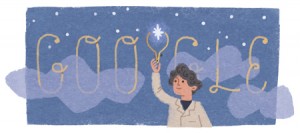Good morning, Whitewater.
Thursday in town will be sunny with a high of thirty-three. Sunrise is 7:16 AM and sunset 4:20 PM, for 9h 04m 56s of daytime. The moon is a waning gibbous with 77% of its visible disk illuminated.
If you’re not yet sure about what you’ll have for lunch today, PES Films helpfully shows the proper technique for making a submarine sandwich —
Google has a doodle today to commemorate the birthday of pioneering American astronomer Annie Jump Cannon:

In 1896, Cannon became a member of “Pickering’s Women”,[10] the women hired by Harvard Observatory director Edward C. Pickering to complete the Henry Draper Catalogue, mapping and defining every star in the sky to photographic magnitude of about 9. Cannon started her work right away, and discovered SS Cygni, a “dwarf nova” that repeats its outbursts about every 60 days.[11]
Anna Draper, the widow of wealthy physician and amateur astronomer Henry Draper, set up a fund to support the work. Men at the laboratory did the labor of operating the telescopes and taking photographs while the women examined the data, carried out astronomical calculations, and cataloged those photographs during the day.[8] Pickering made the Catalogue a long-term project to obtain the optical spectra of as many stars as possible and to index and classify stars by spectra. If making measurements was hard, the development of a reasonable classification was at least as difficult.
Not long after work began on the Draper Catalogue, a disagreement developed as to how to classify the stars. The analysis was first started by Nettie Farrar, who left a few months later to be married. This left the problem to the ideas of Antonia Maury, Henry Draper’s niece, who insisted on a complex classification system and Williamina Fleming, who was overseeing the project for Pickering,[10] and wanted a much more simple, straightforward approach.[6] Cannon negotiated a compromise: she started by examining the bright southern hemisphere stars. To these stars she applied a third system, a division of stars into the spectral classes O, B, A, F, G, K, M. Her scheme was based on the strength of the Balmer absorption lines. After absorption lines were understood in terms of stellar temperatures, her initial classification system was rearranged to avoid having to update star catalogues. Cannon published her first catalog of stellar spectra in 1901.
Cannon and the other women at the Observatory were criticized at first for being “out of their place” and not being housewives. In fact, women could only get as high as assistants in this line of work and were only paid 25 cents an hour for seven hours a day, six days a week.[4] Cannon dominated this field because of her “tidiness” and patience for the tedious work, and even helped the men in the observatory gain popularity. Cannon helped broker partnerships and exchanges of equipment between men in the international community and assumed an ambassador-like role outside of it. She wrote books and articles to increase astronomy’s status, and in 1933, she represented professional women at the Worlds Fair in Chicago.[12]
Cannon’s determination and hard work paid off. She classified more stars in a lifetime than anyone else, with a total of around 500,000 stars. She also discovered 300 variable stars, five novas, and one spectroscopic binary, creating a bibliography that included about 200,000 references.[11] Cannon could classify three stars a minute just by looking at their spectral patterns and, if using a magnifying glass, could classify stars down to the ninth magnitude, around 16 times fainter than the human eye can see.[4]
On May 9, 1922, the International Astronomical Union passed the resolution to formally adopt Cannon’s stellar classification system, and with only minor changes, it is still being used for classification today.[8]
Google-a-Day also poses a geography question:
Due to its vast territory, in 2009 a bill was proposed in Russia to reduce “what,” down from eleven?
